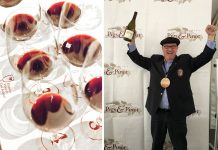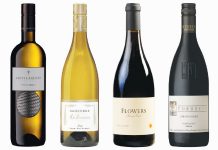Story by Charles Fredy
 When we began planning last May’s ʻAipono Wine Dinner, several committee members doubted a Riesling experience would draw much interest. We often assume that most people don’t like sweet wine. Surprisingly, the wine dinner not only sold out; people had to be turned away. As that evening progressed, I was gratified to see how much our guests enjoyed the sweet wines.
When we began planning last May’s ʻAipono Wine Dinner, several committee members doubted a Riesling experience would draw much interest. We often assume that most people don’t like sweet wine. Surprisingly, the wine dinner not only sold out; people had to be turned away. As that evening progressed, I was gratified to see how much our guests enjoyed the sweet wines.
I would have liked to take their experience further by introducing them to wines grown with Botrytis cinerea, a fungus found on a small percentage of late-harvest grapes. Such wines are more luxurious than typical Rieslings or off-dry wines. They are sweet enough to take the place of dessert, yet when produced correctly, they retain a wonderful acidity, so they’re never cloying.
Collectors and other oenophiles tend to monopolize the market for Botrytis wines, which may be fortunate, because they are a fairly rare commodity. It takes a unique climate and terroir to grow a grape that can produce natural Botrytis — for example, certain areas in France that produce sauternes. Day after day, the morning fills the vineyard with moisture; sunlight warms and dries the fruit in the afternoon. It’s a perfect environment for Botrytis. It also requires considerable commitment on the part of vintners, who must pick the grapes not once or twice, but as many as seven times during harvest season, each pass through the vineyard selecting only those berry clusters that are perfectly mature. And Botrytis sweetens the grape by dehydrating it to about a third of its juice, so the yields are quite small. Put all these conditions together, and you start to understand how rare and exceptional a Botrytis wine can be.
It’s worth seeking out. The beauty of these wines is that they are so complex. Often they are aged in new oak barrels, and have a honeyed, toasty, nutty flavor. Depending on the grapes used, such wines can also have floral layers, ripe fruit flavors, spices. When they are paired with different types of food, different flavors will come to the fore. One of the most remarkable pairings I’ve had was fois gras, glazed mango and Dolce, a Botrytis wine from Napa Valley. The fois gras’s texture and earthy savoriness brought out the savory notes of the wine. A rich bleu cheese with pungent flavors will counter the wine’s sweetness, but be a perfect texture match.
Ready to Experiment? Try these pairings:
- Dolce by Far Niente, Napa Valley, with fois gras and glazed mango
- Chateau Rieussec, Sauternes, France, with Maytag bleu or Roquefort cheese
- Royal Tokaji Wine Company, 6 Puttonyos Aszu, Tokaj-Hegyalja, alone or with poached pear and meringue





